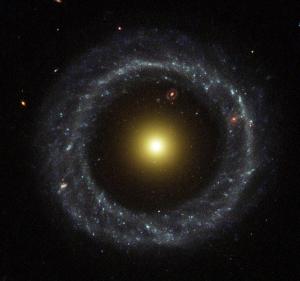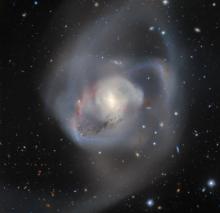A possible collision between two galaxies may have sculpted Hoag's Object, an odd galaxy about 600 million light-years away. It consists of a dense core of old stars surrounded by a ring of younger stars, but there's not much connecting them. A smaller galactic "bullet" might have punched through the center of Hoag's Object, disrupting its original spiral shape. Astronomers have proposed several other suggestions for the beautiful galaxy, which is unlike any other yet seen. [NASA/Hubble Heritage Team (STScI/AURA]
You are here
Hoag’s Object
It’s hard to look at Hoag’s Object and not think of food. The galaxy’s core looks like an egg yolk, while a ring of stars around it resembles a glazed doughnut. The problem for astronomers is that they’re not sure of the recipe that cooked it up.
Hoag’s Object is about 600 million light-years away. It stands high in the southwest at nightfall, just below the semicircle of stars known as Corona Borealis, the northern crown.
The galaxy’s ring appears to be giving birth to many new stars. But unlike other ring galaxies, there’s not much material connecting the ring to the core.
Hoag’s Object might have started as a spiral galaxy, but was shot through by a smaller galactic “bullet.” The impact would have created ripples that reshaped the spiral. But there’s no evidence of a second galaxy anywhere close.
Another possibility is that a second galaxy sideswiped the bigger spiral. The second galaxy would have been pulled apart and its stars and gas incorporated into Hoag’s Object. But there are problems with this idea, too.
A third possibility is that the galaxy originally had a long bar of stars across its middle. The motions of the bar would have whipped up the galaxy like egg whites in a blender — yet another reminder of food.
So far, astronomers haven’t seen any other galaxies that are just like Hoag’s Object. That leaves them with little help as they try to decipher the recipe for this tasty-looking galaxy.
Script by Damond Benningfield
Get Premium Audio
Listen to today's episode of StarDate on the web the same day it airs in high-quality streaming audio without any extra ads or announcements. Choose a $8 one-month pass, or listen every day for a year for just $30.







